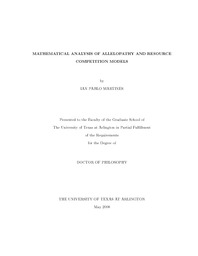| dc.contributor.author | Martines, Ian Pablo | en_US |
| dc.date.accessioned | 2008-08-08T02:31:15Z | |
| dc.date.available | 2008-08-08T02:31:15Z | |
| dc.date.issued | 2008-08-08T02:31:15Z | |
| dc.date.submitted | May 2008 | en_US |
| dc.identifier.other | DISS-2077 | en_US |
| dc.identifier.uri | http://hdl.handle.net/10106/980 | |
| dc.description.abstract | Mathematical population models of nutrient recycling and allelopathy are presented. The chemostat limited-resource model forms the basis for each of the models, amended with the dynamics of nutrient recycling and allelopathy. Nutrient recycling considers the explicit mortality of the population as providing additional recycled nutrient available to the remaining organisms. Also considered is allelopathy in which one population produces a poison to increase the mortality of another population. In this study we explore allelopathy in which the poison producer increases toxicity as the nutrients are limited. In addition to the chemostat model, we also consider the associated gradostat, two chemostat devices in series. Local analysis and numerical simulations are presented for each of the models along with global results where available. | en_US |
| dc.description.sponsorship | Kojouharov, Hristo | en_US |
| dc.language.iso | EN | en_US |
| dc.publisher | Mathematics | en_US |
| dc.title | Mathematical Analysis Of Allelopathy And Resource Competition Models | en_US |
| dc.type | Ph.D. | en_US |
| dc.contributor.committeeChair | Kojouharov, Hristo | en_US |
| dc.degree.department | Mathematics | en_US |
| dc.degree.discipline | Mathematics | en_US |
| dc.degree.grantor | University of Texas at Arlington | en_US |
| dc.degree.level | doctoral | en_US |
| dc.degree.name | Ph.D. | en_US |
| dc.identifier.externalLink | https://www.uta.edu/ra/real/editprofile.php?onlyview=1&pid=23 | |
| dc.identifier.externalLinkDescription | Link to Research Profiles | |

